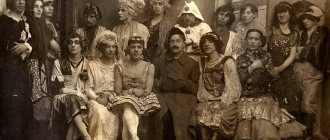Who is given strict regime?
A particularly strict provision is provided for persons: Those who have committed particularly serious crimes and those sentenced to life imprisonment (Article 58 of the Criminal Code, Article 74 of the Penal Code).
Interesting materials:
How to change the Bx tariff? How to change currency at a Sberbank ATM? How to understand tubeless or not? How to understand that your ex-wife wants to come back? How can I tell if I'm arrogant? How do you know when a coconut is ripe? How to understand that a man is emotionally attached? How can you tell if a pomelo is ripe? How do you know if a reaction is irreversible? How to understand what naive is?
Peculiarities of life and work in the Tobolsk “krytka”
It was located in three 2-story buildings, of which one was working, the other two were non-working. The first accommodated 300, the second - 400 people. Non-working (special building No. 2) is a place where thieves in law and malicious violators are housed, as well as those who categorically refused to work. The conditions in this building were the most terrible. It had single, double and five-person cells. There were approximately 50 of them each. Singles and doubles were located opposite 5-bed common cells on both sides of the corridor. The only rights that those kept here had were a short walk once a day and a bath once every 10 days (it was organized in a special cell where there were basins and hot water).
The conditions of the working building are “improved”. There were also “good” and “bad” cameras. The latter were called “scabies”; prisoners from them were taken to work one at a time. From the “good” ones - all together, through a common exit leading to an underground tunnel, combined with the cells of the working building, where the prisoners worked locked up all day.
Prison and life behind bars
The small Ural town of Zlatoust, located in the Chelyabinsk region, is famous for the birthplace of the famous Russian storyteller Pavel Bazhov. However, this town received no less fame due to the fact that the most famous prison in Russia is located there, where dangerous criminals were kept. It all started in the 18th century, when iron ore and weapons factories began to be built en masse in the Urals. Some of them belonged to private owners, and some to the treasury. The Zlatoust arms factories initially belonged to the Russian state, so the order there was strict, but not unlimited, as, say, at the factories of the merchant Demidov, where violators of law and order were simply drowned in the nearest pond.
In Zlatoust everything was done according to the law. For absenteeism, drunkenness, fights and other sins, artisans were imprisoned in the factory lockup for a certain period of time. After serving their sentence, the prisoners returned to their workplace. In case of relapse, the sentence was doubled. Therefore, some violent troublemakers spent more time in the dungeon than in the factory floors and died on hard prison bunks. After the defeat of the Pugachev riot, hundreds of participants in the uprising were kept in factory casemates, and some of them were executed there.
In 1874, as part of the prison reform, the factory prison was transferred to the city and a fairly liberal regime was established there. Archives show that during this period there were regular escapes from the prison. During the Civil War, the Zlatoust Prison was used by both the Whites and the Reds, carrying out acts of mass terror there, or, simply put, executions. Then for a long time it was a provincial prison for petty swindlers.
Everything changed on January 28, 1939, when order No. 0098 compiled a list of “special NKVD prisons.” Initially, among them were Butyrskaya, Lefortovo, Sukhanovskaya, Inner, Vladimirskaya, Vologda, Novocherkassk, Khabarovsk and Zlatoust prisons (later this list was expanded). A stricter regime was established in these prisons, and the staff of guards, who were paid increased salaries, was significantly increased. In “special prisons” it was planned to contain the most dangerous prisoners, both criminals and political ones. Before that, in the USSR all convicts were sent to spend their time in forced labor camps. They were located in remote areas of the country, but still there the prisoners were constantly in the fresh air. Now some of them were doomed to spend many years in a closed “stone bag”. This is how “krytki” appeared for the first time in the USSR - prisons intended for people who had already been convicted by a court and received their sentence.
It was not by chance that the Ural prison was on this ominous list. Zlatoust was located in the very depths of the country, far from the main cultural and industrial centers, which made it easier to prevent escapes. On the other hand, there was a railway there, which made it easier to transport prisoners. Therefore, prisoners of various ranks were actively sent to Zlatoust, including artists, academics, scientists, and military personnel.
Among them, for example, was the playwright and writer Alexander Klein. He was born in Kyiv, graduated from two courses at the Leningrad Theater Institute. During the war he was captured by the Germans, and after his release he spent twelve years in the Gulag. Of these, five years were spent in Zlatoust prison.
Academician V.V. served part of his sentence there. Parin, secretary of the USSR Academy of Medical Sciences, sentenced to twenty-five years for “divulging state secrets.” Colonel N. Zabotin, deputy military attache to the United States, and in fact a resident of Soviet intelligence, who participated in the race for American nuclear secrets, was also sitting there. It was he who supervised the Rosenbergs and was in touch with them, receiving secret information about the nuclear bomb. N. Zabotin had some kind of conflict with Lavrentiy Beria and the all-powerful Marshal of State Security sent his subordinate to a “covered zone”.
Beginning in 1956, political prisoners were no longer sent to Zlatoust. Their place was taken by seasoned criminals. Only those who systematically violated the regime of stay in a correctional colony, as well as malicious repeat offenders convicted of serious crimes, were sent to the Zlatoust “krytka”. The Soviet Criminal Code had a special clause according to which, when imposing a maximum term of fifteen years, the judge could assign the convicted person the first five years of serving the term not in a correctional labor camp, but in prison. This was an additional punishment.
From the colony, the administration could send the offender to a “closed” colony, also for a period not exceeding five years, after which he would return to the zone again. But these five years in the “covered” were quite enough.
According to the recollections of eyewitnesses, the conditions of detention of prisoners in the Zlatoust prison were very harsh and, perhaps, the most difficult of all Soviet “krytok”.
The cells were very cold, dark and gloomy. The guards constantly mocked the prisoners, set dogs on them, and beat them with rubber sticks and hammers. Under the pretext of routine checks, personal belongings, especially warm clothes, were confiscated and damaged from convicts, already meager food parcels were taken away, and bread distribution standards were reduced. According to stories, in those days the game of cards for blood flourished in the “krytka”. The loser opened his veins and poured blood into a mug. The cellmates fried it in a metal mug on a torch made from newspaper and ate it.
However, according to the concepts, such things were condemned and severely punished. Those found guilty of bloodthirsty were excommunicated from the brotherhood of thieves and, on occasion, “let go.” Most of the prisoners in the Zlatoust prison “sat on a pound”, receiving 450 grams of bread and a bowl of gruel per day.
In the 70s, the legendary thief in law Vasya Brilliant, as well as his friend Vasya Korzh, an authoritative thief from Vladivostok, hung out in Zlatoust. The latter was known as a jailed “grouse,” that is, a person who had spent twenty-five years in prison.
In the early 80s, the authorities of the Georgian SSR petitioned the Union Ministry of Internal Affairs so that their crime bosses would serve their sentences away from their native republic. From that moment on, many thieves appeared in Zlatoust - southerners. Datiko Tsikhelashvilli, the famous Dato Tashkentsky, served part of his sentence here. Subsequently, he became the leader of the criminal movement throughout Siberia and the Far East.
Thus, a significant number of authoritative thieves in law were kept in the Zlatoust prison. Therefore, meetings were regularly held in the “krytka” and the coronation of new “thieves in law” took place. The administration, of course, tried to fight this, but to no avail.
With the beginning of perestroika, the rank of the Zlatoust prison changed somewhat. It received the status of a regional pre-trial detention center (institution IZ 74/4), but with a prison department. Thieves in law gradually left its “hospitable” walls, and in their place a simpler public appeared: bandits, scammers, racketeers, sexual maniacs. However, the most famous prisoner of this period was Pavel Yakshiyants, who in December 1969, together with three accomplices, seized a bus with children in the city of Ordzhonikidze (now Vladikavkaz) and managed to fly to Israel. But the bandits stayed abroad for only three days, after which they were extradited back. The feature film “The Crazy Bus” was shot about these tragic events. While in the Zlatoust "krytka", Yakshiyants took two female controllers hostage, tried to escape, but was captured and, of course, received an additional sentence.
In July 2003, the prison department of the IZ 74/4 institution was disbanded. The 800 convicts who were there were scattered among the prisons of Verkhneuralsk, Vladimir and Yeniseisk. Thus, the famous Zlatoust “krytka” ceased to exist and turned into an ordinary pre-trial detention center.
Recently renovations were carried out there. The walls of the gloomy casemates were repainted in soft blue and beige tones. The reconstruction began with new European Union requirements for the detention of pre-trial and convicted prisoners. Modern plumbing was installed in the cells. Each person under investigation was allocated (in accordance with European Union requirements) at least four square meters of cell area.
Now there are no more than six people in a “hut”, but previously their number reached twenty people. There are also double cells in the pre-trial detention center; prisoners with poor health are placed there. The plans include providing those under investigation with televisions, electric kettles, and microwaves. In general, prison reform continues.
Based on materials from the newspaper “Behind Bars” (No. 2, 2011)
"Press Hut" and punishment cell
“Press Hut” is a special place where, with the help of physical and mental pressure from people (other prisoners), prisoners were deprived of their will, intimidated and even deprived of their lives. Moreover, even for one careless word. The wardens had virtually unlimited power (so much so that any murder could be written off as a “heart attack”). It was practiced as a punishment to send a prisoner stripped naked to a punishment cell, where the conditions of detention were the most terrible. Low ceilings, ankle-deep water on the floor, rats walking around.
COVER
“Krytka” is what they call a prison, quite expressively and succinctly, in the criminal environment and in the circle of professionals diametrically located to them. However, in fairness, it should be noted that many words from “feni”, phrases, concepts - cf.: even this, an ordinary word, acquired a very specific, anti-legal! - interpretation: “to live according to concepts”, quietly migrated not only into everyday life folk speech, but also strictly official speech. Alas, the language of Tolstoy, Chekhov, Turgenev, the oratory of Plevako, Kony is now less popular than the implanted vulgarisms that vulgarize the Russian language. All this causes a feeling of awkwardness. Although for stupid heads the illusion of closeness to the people of statesmen is created. But let us attribute this remark to passing retreats. I'll tell you a little about the prison itself.
The first cells in Hämeenlinna prison were opened to its clients in 1871. The prison was then called the House of Correction for Men. Ten years later, after its opening, the prisoners of the correctional house were transferred to the Helsinki prison, and the building itself was expanded. In the northern wing, women's cells began to be located on four floors. The women's block was destroyed in 1976.
The prison in Hämeenlinna existed for a long time. The last prisoners were transferred on March 15, 1993 to the prison in the town of Kylmäkoski /Cold (river) rapids/. In connection with this name, by analogy, the oldest prison on Kholodnaya Gora in Kharkov comes to mind. It seems that A. Gaidar mentioned her in his story “The Fate of the Drummer.”
Below I present to your attention photographs. Unfortunately, the technical conditions were not particularly suitable for high-quality shooting and did not meet my hopes.
1.overview photo of the place. On the left is the prison building, in the foreground is the castle, and further to the left is the military museum
2.prison-museum building
3. The prison length / cells are located on three tiers, covered with interfloor nets - traps
3.1 clients are received in this room
4. Camera "hut". Shkonki bunk beds in two tiers.
4.1 handicraft items, attributes of chamber life, homemade eraser cards, various secret pencil cases, a diary, etc.
5. security room
6. In-chamber wiretapping room. Do not chat! - relevant at all times.
7.shower room with sauna/!/
8. bathroom 9. A thief will never become a laundress, but she hasn’t given up the spinning wheel
10. content “denied”, transfer of especially dangerous state criminals / distant times
11. ironclad arguments
12. old prison uniform
13. robe of a prisoner and a guard
GO IN - DON'T BE AFRAID, WHEN GOING OUT - DON'T BE REJOICED.
photographs taken by the author© August 2013








